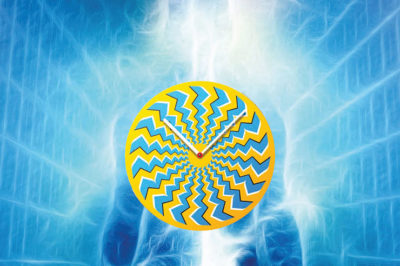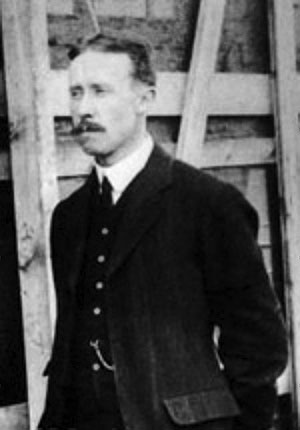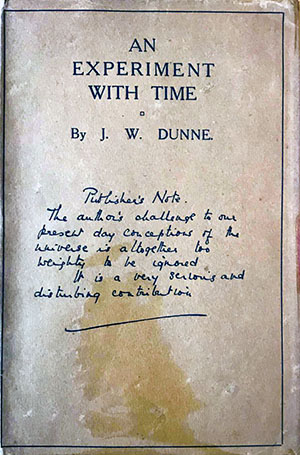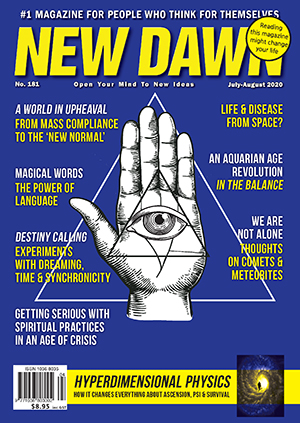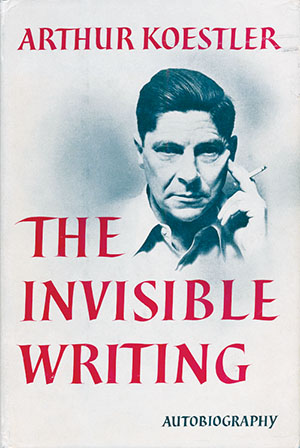From New Dawn 181 (Jul-Aug 2020)
This article about synchronicities and precognitive dreams was originally published in Quest magazine in 1997. At the time I wrote it, I didn’t have access to the dream journals I mention in it, and so had to rely on memory. Since then I have retrieved the journals from Los Angeles – where they were slumbering in storage – and at present am working on a book about dreams, time, and the strange relationship between. This article can serve as a taster for the full-length treatment to come.
Since around 1980, I have kept, more on than off, a dream journal. Some years are less accounted for than others, but on the whole I have a fairly well-stocked entry book for what was going on in my sleeping mind over the last seventeen years.
I began the journal after reading an amazing book, An Experiment with Time, by J. W. Dunne. In it, Dunne, an aeronautics engineer,tells how he discovered that he could dream the future. One night heawoke from a dream in which he had been arguing with someoneabout the time. He said it was 4:30 a.m. In the dream Dunneassumed, with the strange logic of dreams, that his pocket watchmust have stopped; he reached for it to check, and found that it had. He then woke up.
A curious sort, Dunne decided to see what time it “really” was. He found his pocket watch and looked: it had stopped at precisely 4:30. Dunne assumed he must have noticed this earlier, forgotten it, also forgotten to wind the watch, and dreamed about it. He wound the watch and went back to bed. When he woke later, he assumed he’d have to fix the time, since he had no idea what time it was when he wound the watch the night before. When he checked the watch against a clock, he was surprised to discover it was correct. The watch had stopped at 4:30 a.m.
More odd things happened. Lying in bed one morning, Dunne found himself wondering what time it was. He tried an experiment. He closed his eyes and “fell into one of those semi-dozes in which one is aware of one’s situation” – what we’d call a “hypnogogic state” – and concentrated on knowing what time it was. He saw an image of his watch, poised in front of him. It said two and a half minutes past eight (Dunne is meticulous with details). He opened his eyes and reached out for his watch. His vision was correct: the time was two and a half minutes past eight.
Not long after, Dunne had a dream in which he was in Egypt, near Khartoum. He saw three men approaching from the south, dressed in ragged army uniforms, very much like those of the soldiers he had recently been fighting in the Boer War in South Africa. In the dream he wondered why they should travel on foot from the bottom of the continent to the top, and asked them. They replied that was precisely what they did. The next morning he saw a news headline: “The Cape to Cairo: Expedition at Khartoum,” over a story describing the expedition he had dreamed about.
But perhaps the most thrilling dream was of the eruption of Mont Pelee on the island of Martinique in 1902. Dunne dreamed he was on an island, and that cracks and fissures had opened under his feet. Steam escaped from these openings, and in the dream Dunne realised that the island was about to explode. He knew he had to escape, and tried to help the 4,000 people he knew would be killed. The next morning the newspaper carried a story about the disaster. Dunne was off on the number of people lost; it was 40,000, not 4,000. But this discrepancy proved a key to his experience. When reading of the disaster, Dunne had hastily read that 4,000 people had been killed. It was only later that he went back and saw that he had misread the newspaper. Dunne realised that he wasn’t dreaming about the actual events – the volcano or the expedition – but about his reading about them in the morning paper. He had dreamed the future, but it was his own, specific future – in which he misread the number in the newspaper.
This led Dunne to believe that what he was experiencing was, odd as it sounds, “normal.” He hadn’t developed some strange power to see the future; our ideas about time, he believed, were wrong. We usually think of time moving in a definite order: past, present, future. Dunne’s dreams were giving him his usual experience but in a different order. After studying many dreams, Dunne concluded that they were made up of a mixture of past and future events. We usually don’t notice this because, for one thing, we easily forget our dreams, and for another, we usually pay very little attention to our experience.
Dunne went on to write a series of interesting books in which he developed his philosophy of “serialism,” a somewhat complicated metaphysic of different “times,” each encompassing the other. While making for fascinating reading, Dunne’s theory leaves us with an infinite regression of “selves,” each one, as it were, looking over the previous self’s shoulder. Dunne argued that the only way we can notice that one time is different from another is for there to be a consciousness outside of the two times and able to compare them. So, Time 1 is everyday time of past, present, and future. Time 2, which includes Time 1, is the time of dreams, where the future mixes with the past and present. Time 3 looks at Time 2 and compares it to Time 1, and so on until we arrive at the ultimate timekeeper, God, who is aware of all times simultaneously. The vision is inspiring but, to me at least, unsatisfying. If you think of the infinite reflections we get when we hold one mirror up to another, you’ll see what I mean.
After reading Dunne’s books, I decided to keep a dream journal. I had been interested in dreams already through reading C. G. Jung and had occasionally written down unusual ones. And I had been interested in the strange character of time through reading the Russian philosopher P. D. Ouspensky. In Tertium Organum, New Model of the Universe, and his novel, The Strange Life of Ivan Osokin, Ouspensky, like Dunne, started from the recognition that our usual ideas about time are inadequate. Ouspensky explored the idea of eternal recurrence – the notion that our lives repeat over and over again. Ouspensky believed this was responsible for déjà vu, and speculated on a six-dimensional time. Time is strange, Ouspensky knew, and like Dunne he felt that our usual account of it was sadly inaccurate. Other writers followed, including T. C. Lethbridge and J. B. Priestley.
Lethbridge is best known for his work with pendulums, but in his last years he wrote about “Dunne type dreams.” Priestley called himself a “time haunted man,” and was influenced by both Dunne and Ouspensky. His reflections on time and dreams can be found in his books Man and Time and Over the Long High Wall. He also wrote plays based on Ouspensky’s theories – Time and the Conways and I Have Been Here Before.
Future Dreams
Having said this, I should mention that I don’t have a theory to account for “future dreams.” Dunne’s serialism doesn’t satisfy me. Ouspensky’s speculations on the fourth, fifth, and sixth dimensions offer more to go on, but I think they are a beginning, not an “answer.” To tell me I dream the future because time is six-dimensional is fine, as long as you also tell me how that answers it. Unfortunately, when I discuss this with friends, I usually get an answer similar to this, which suggests to me more a disinclination to take on the difficult business of thinking than a sure grasp of the metaphysics of temporal displacement.
What I first discovered in following Dunne’s example is that he was right: bits of the future did turn up in my dreams, but nothing as thrilling as a volcano (although they did turn up later). What came through were trivial items. I dreamed of playing a red guitar. I didn’t own one, nor did I know anyone who did. But later that day, through a chance meeting, I wound up at someone’s apartment, and this acquaintance handed me a red guitar, asking me to “check this out.” I started strumming and only then remembered I had written about this in my journal that morning. I dreamed of sitting cozily with an attractive woman I knew slightly; I chalked that one up to Freudian wish fulfilment until, again through a chance connection, I found myself in a more intimate setting than I would have expected with the woman in question. Similar dreams followed, enough to convince me that something more than mere coincidence was at work here.
One of my earliest “future dreams” proved to be a “vision” of an event that took place months later. I had dreamed of riding on the back of a motor scooter with someone I didn’t know through an unfamiliar neighbourhood. The landscape was hilly, with palm trees and other vegetation not native to Manhattan, where I was living at the time. In a particularly memorable part of the dream, we were passing large trucks with the words “cosmic consciousness” painted on the side. An odd enough dream to begin with, but then, months later, I found myself on the back of a Vespa, riding with a newly made friend through the Silverlake district of Los Angeles, to where I had just moved from Manhattan. We passed the hills I had seen in the dream, also the palm trees. But in place of the trucks, something else was there. As we passed a street with the same name as my friend – I remember pointing it out to him – I remembered the dream. Suddenly I was hit with a strong dose of déjà vu, and a feeling that walls of some sort had just fallen, and that my awareness of things expanded in all directions: a close enough description of a snippet of “cosmic consciousness” to get me thinking about what exactly was going on. Around the same time as this “waking” event I had a very powerful lucid dream – these are dreams in which we know we are dreaming – featuring the same friend that generated the same odd feeling of expanded awareness.
Two things came from that dream: the realisation that some future events appear “distorted” – or “symbolically,” depending on how you look at it – in dreams, and that the recognition that “you have dreamed this” is accompanied by a peculiar sensation and emotion. The dream was, as it were, fulfilling its own prophecy: I had dreamed about cosmic consciousness, and remembering the dream when in the same situation in waking state produced a sensation of expanded awareness. Ouspensky said certain kinds of knowledge aren’t available unless we’re in the right emotional state. I had begun my experiment in a spirit of scientific objectivity but soon saw that I couldn’t treat dreams as we do other objects of study. They aren’t dead specimens, as many “scientific” dream researchers seem to regard them. To understand them fully, a certain emotional warmth, much as we direct toward people, is necessary.
In the years that followed I collected more “future dreams.” Certain patterns emerged, as well as more characteristics that Dunne didn’t mention. My reading of Jung had made me aware of the psychological value of dreams, their meaning as indicators of what Jung called the “individuation process,” an approach to dreams apparently unfamiliar to Dunne. This meant that I began to think not only of the puzzles of time and consciousness that “future dreams” present, but also what these glimpses meant for me. Two books deal with related phenomena from this perspective: Ray Grasse’s The Waking Dream [1996] and Victor Mansfield’s Synchronicity, Science, and Soul-Making [1995].
Some of the patterns dealt with time itself. The dreams came in cycles. There would be several in a week, then none for a few months, then another flurry. Some of the most spectacular related to films. During a period of intense Jungian study, I dreamed about a film of the old 1930s pulp character the Shadow – not unusual for a reader of Jung. I knew of no such film and, though I had been a great fan of the pulp revival in my youth, I hadn’t thought of this character in years. In the dream, the Shadow appeared as a two-dimensional figure on a wall, then popped out and became three-dimensional. I had this dream in 1990. In 1994, I went to see the film The Shadow, starring Alec Baldwin, and saw exactly what I had seen in my dream. Sometime before, a friend who was working on Francis Coppola’s version of Dracula had invited me to a screening. A few nights before, I had a frightful nightmare in which I rescued a woman friend from some gruesome face in a strange, Hieronymous Bosch-like village. Wolves hung upside clown on crosses, fires burned, throwing up blood-red shadows and thick, black smoke, and foul-looking characters waded through arms, legs, and other body parts, carrying axes and pikes. It was a charnel house, something out of one of Emanuel Swedenborg’s hells. Truly evil. I went to the screening and saw what I had dreamed: the film begins with a scene of Vlad the Impaler’s handiwork – crucified wolves, fires, blood and gore. In both instances the “feeling” was there, what I started to call the “timeslip.”
Synchronicity Cloud
Along with emotionally charged dreams, there were many about trivial, everyday matters. I would be standing at a street corner and notice a car pass by and realise I had dreamed this the night before. I dreamed of a fountain, with terracotta steps rising on either side. In the dream, this was somewhere in Italy. That day, by chance, I got a lift from a friend into Hollywood and decided to get out a few blocks from my destination and walk the rest of the way. When I got out of the car, there were the fountain and steps; it was not Italy, but Sunset Boulevard. And the feeling. Not exactly déjà vu, but an odd mixture of this and another sensation described by Ouspensky, from his studies with Gurdjieff, called “self-remembering.” Jungian friends “explained” my dreams as “synchronicities.” I had no doubt they were, but didn’t see how calling them this rather than “coincidence” told me anything about how they happened.
I noticed that certain psychological conditions seemed, if not to cause the dreams, at least to accompany them more than others. States of tension or, conversely, of great interest and happiness seemed to be preferable to an even keel. Tension produced an uncomfortable feeling that the membrane separating dream from reality – shaky distinctions at best – had been perforated. Situations in which I would hear, metaphorically, the Twilight Zone theme would produce a feeling that I was “dreaming” while awake, and it took some effort to keep up appearances and not turn tail. It seemed then that the dream feeling was seeping into my waking life and that my consciousness consisted of a muddle of the two. Conversely, when happy, alert, and expectant, I would find synchronicities popping up almost a dime a dozen.
Once, on a weekend trip to San Francisco, it was as if I had stepped into a “synchronicity cloud.” Not only had I dreamed several small events of the day, but I found myself bumping into coincidences left and right. For example, I had been reading Edgar Allan Poe’s stories and had just read about a particular character with an unusual name. I looked up at the building I was standing in front of: the same name was emblazoned across the storefront. Several similar things happened. Likewise, at the start of a move to Europe, I was waiting for my flight at JFK airport, reading The Glass Bees by the German writer Ernst Junger, himself a connoisseur of dreams and psychic phenomena. The hero was describing how, during his military training, his cavalry sergeant had taught him the value of learning how to fall by deliberately arranging a slip from the saddle. The moment I read this, I looked up to see a large man fall flat on his back.
I mention synchronicities because, although some of my “future dreams” were clearly related to my psychological development, many weren’t. Jung defines synchronicities as “meaningful coincidences,” having to do with our “individuation,” our growth and maturity. I mentioned volcanoes earlier. Several years ago, I woke from a dream in which my ex-wife and I were with her uncle in Japan. He was helping us escape from a flood of lava and urging us to hurry. I had never met her uncle nor been to Japan; I also hadn’t heard about the volcano that had erupted there that week until after the dream. Synchronicity? But what had volcanoes in Japan to do with my psychological growth? Again, a few years ago, I dreamed of tremendous explosions and devastated landscapes; only later that day I realised it was August 6, the anniversary of Hiroshima, something I hadn’t remembered until then. Some “future dreams” were perhaps telepathic; my ex-wife may have been in rapport with her uncle in Japan, and I may have picked up her intuition, but she didn’t mention it to me, nor was she aware of the volcano. In any case, this seems to me a case of synchronicity with no particular meaning for me. Yet some other dreams clearly did have meaning. One night I dreamed of a man’s face directly in front of mine; it was nasty, and he was shouting. That night I went to an outdoor concert at the Hollywood Bowl. There was a misunderstanding about my seat, and I lost my temper with an usher; naturally enough, he replied in kind. Only later did I realise his was the face in the dream. Had I been more aware, I could have avoided a foolish argument.
The Invisible Writing
But my most striking dreams are ones in which I feel some “intelligence” is communicating with me, giving guidance and advice. With these, I’m convinced something not “myself” is at work. I dreamed of dancing in a circle of Tibetan monks. We were passing a ball of yarn back and forth; when the ball came to me it began to unravel. We held onto the edges and danced; the yarn opened up and a beautiful mandala appeared. I woke feeling that something extraordinary had happened. That day, in the bookstore I managed, a colleague told me he had found a picture of me in my past life. I laughed as he pulled out a copy of Alexandra-David Neel’s Secrets of Tibetan Yoga and showed me the back cover. There was a photo of a pudgy, cherubic monk with round glasses, the kind I wore. I hadn’t mentioned the dream. The friend said this meant I should take up Tibetan Buddhism. I thought it meant I was on the “right path” already.
One last dream. At the same bookstore I made a habit of putting books aside, thinking I might buy them. One was The Invisible Writing, Arthur Koestler’s autobiography. Koestler wrote of how he had abandoned the “scientific” materialist outlook of his youth while waiting to be shot as a prisoner during the Spanish Civil War. To pass the time in his cell, Koestler worked out the mathematical proof that there is no highest prime number. He became so absorbed in this that he had a kind of mystical experience; only a small nagging at the back of his mind distracted him. “Oh, yes,” he remembered, “I may be shot tomorrow. Is that all?” Koestler then realised he had been wrong to think the reality of the world could be found in the Marxist rationalist thought he had been trained in, the visible proofs of history, economics, and sociology. Reality lay in what he called “the invisible writing,” the intuition, poetic and mystical. The experience changed his life. He left Marxism and devoted himself to exploring human creativity and the meeting points of science and mysticism.
At the time I found Koestler’s book, I was facing a crisis: I had to decide whether to carry on with a PhD program or take a chance on writing, as I had always wanted to do. The doctorate would mean security, a job, prestige, but it would also mean letting go of my unorthodox interests, such as future dreams, and becoming a “serious” scholar. I decided not to buy the book. That night I dreamed that I returned to the store and bought The Invisible Writing. Wish fulfilment? But “bought” in slang means to accept, to believe. The dream was telling me to buy more than the book; it told me to “buy” the idea of “the invisible writing,” a point that came home literally when I borrowed a biography of Jung that night and opened it at random to a chapter describing his ideas about dreams as messages from a hidden self. The chapter’s title? “The Invisible Writing.” I didn’t finish graduate school.
The above article originally appeared in Quest: Journal of the Theosophical Society in America, Vol 85, Issue 12.
Gary Lachman’s new book is Dreaming Ahead of Time: Experiences with Precognitive Dreams, Synchronicity and Coincidence, available from all good bookstores and online retailers.
© New Dawn Magazine and the respective author.
For our reproduction notice, click here.

